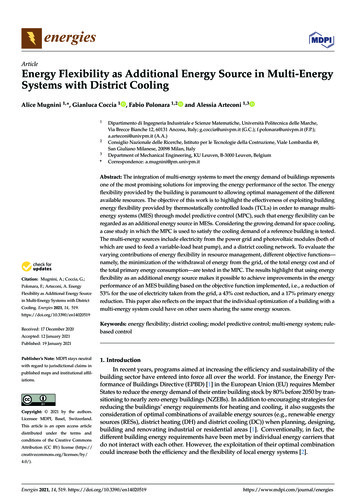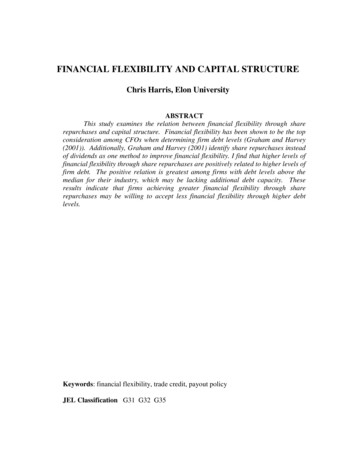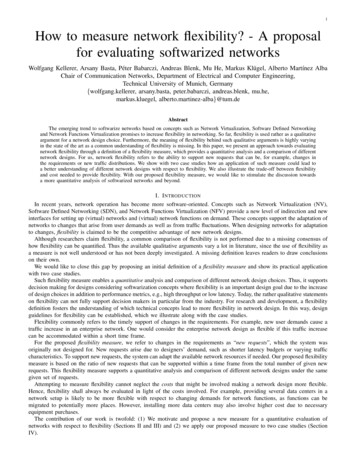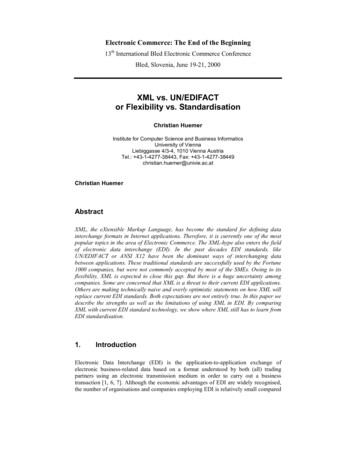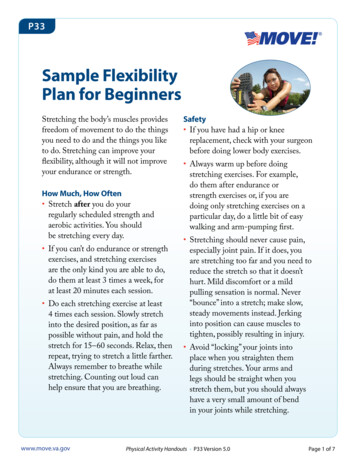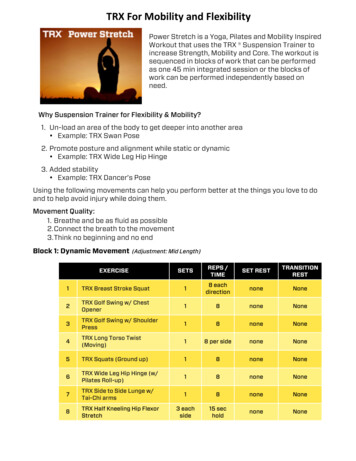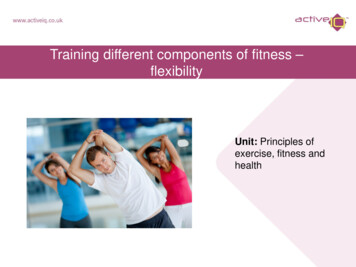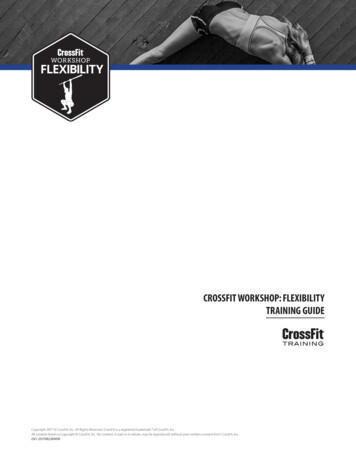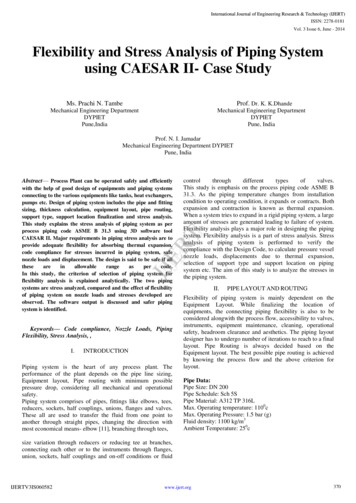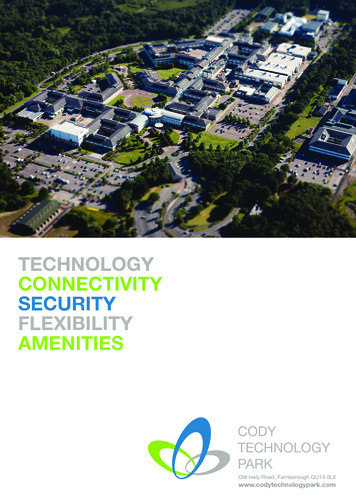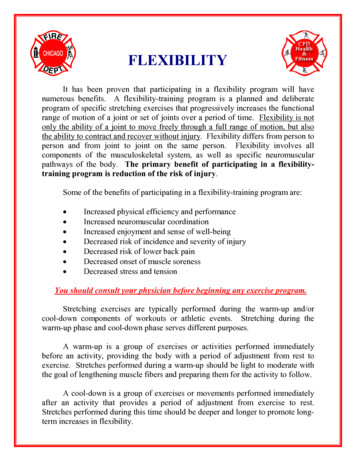
Transcription
FLEXIBILITYIt has been proven that participating in a flexibility program will havenumerous benefits. A flexibility-training program is a planned and deliberateprogram of specific stretching exercises that progressively increases the functionalrange of motion of a joint or set of joints over a period of time. Flexibility is notonly the ability of a joint to move freely through a full range of motion, but alsothe ability to contract and recover without injury. Flexibility differs from person toperson and from joint to joint on the same person. Flexibility involves allcomponents of the musculoskeletal system, as well as specific neuromuscularpathways of the body. The primary benefit of participating in a flexibilitytraining program is reduction of the risk of injury.Some of the benefits of participating in a flexibility-training program are: Increased physical efficiency and performanceIncreased neuromuscular coordinationIncreased enjoyment and sense of well-beingDecreased risk of incidence and severity of injuryDecreased risk of lower back painDecreased onset of muscle sorenessDecreased stress and tensionYou should consult your physician before beginning any exercise program.Stretching exercises are typically performed during the warm-up and/orcool-down components of workouts or athletic events. Stretching during thewarm-up phase and cool-down phase serves different purposes.A warm-up is a group of exercises or activities performed immediatelybefore an activity, providing the body with a period of adjustment from rest toexercise. Stretches performed during a warm-up should be light to moderate withthe goal of lengthening muscle fibers and preparing them for the activity to follow.A cool-down is a group of exercises or movements performed immediatelyafter an activity that provides a period of adjustment from exercise to rest.Stretches performed during this time should be deeper and longer to promote longterm increases in flexibility.
WARM-UPAn effective warm-up consists of the following two phases. This importantprocess will improve the quality of your workout and accelerate your recovery.Phase 1: General warm-up. This phase consists of 5 to 10 minutes ofactivity, such as stationary cycling, jogging, light calisthenics, fast walking,running in place or jumping jacks. The intensity should be enough to increase thebody core temperature and cause a light sweat, but not fatigue.Phase 2: Specific warm-up or pre-stretch. The specific warm-up phaseinvolves 5 to 10 minutes of movements that either mimic or are similar to theactual performance of the activity to follow. This phase includes light sportstretches. The stretching techniques that are most effective during this pre-stretchphase are held less than 10 seconds or are controlled dynamic stretches throughouta range of motion.The biggest misconception is that stretching is the warm-up. The pre-stretchcan be an optional part of the warm-up and should never replace the general warmup.A warm-up will: Increase the speed of contraction and relaxation of warmed muscles. Reduce muscle stiffness. Help nerve transmission and muscle metabolism at higher temperatures. Increase blood flow through active tissues as local vascular beds dilate,raising metabolism and muscle temperatures. Provide greater economy of movement because of lowered resistancewith warm muscles.COOL-DOWNThe cool-down provides many benefits. It facilitates muscular relaxation,promotes the removal of metabolic waste products, reduces muscle soreness, andallows the cardiovascular system to adjust to a lowered demand. Your body willhave built-up chemicals in your muscles and you may also have incurred acollection of microscopic strains and tears. A cool-down simply raises yourbreathing without overstraining your muscles. It also increases the concentrationof oxygen within the blood. The cool-down is a group of exercises or movementsperformed immediately after an activity that provides the mind and body with aperiod of adjustment from exercise to rest. The cool-down is the optimal time to2
improve long-term flexibility due to the increased muscle temperature createdduring the activity.An appropriate cool-down will: Aid in the dissipation of waste products, including lactic acid.Reduce the potential for DOMS (delayed onset muscle soreness).Reduce the chance of dizziness or fainting caused by the pooling ofvenous blood at the extremities.Reduce the level of adrenaline in the blood.FACTORS THAT INFLUENCE FLEXIBILITY POTENTIAL Past and current injuriesInjuries can decrease joint range of motion temporarily, and sometimespermanently. Lack of activity, usually associated with injury, also causes loss offlexibility. Lifestyle and current activity levelA sedentary lifestyle usually results in the loss of flexibility. Regularparticipation in physical activity involving a full range of motion generallyenhances flexibility. Body composition/body typeRange of motion is not affected by arm or leg length, arm span, height, orweight. However, an obese person may be very flexible, but may have a limitedrange of motion depending on the type of stretch performed (due to low adiposetissue in the abdominal area). AgeThe aging process involves a loss of elasticity of connective tissues,including the tissues surrounding muscles. Regular exercise and stretching canminimize age-related muscle shortening and loss of flexibility. GenderAt any age, females tend to be more flexible than males. This is due toanatomical variations in joint structures.3
Muscle temperatureAn increase in body temperature due to participation in physical activityincreases the range of motion. Lowering the body temperature results in decreasedflexibility. Ability to relaxReduction in internal tension facilitates elongation of connective tissue,enabling you to have more range of motion.STRETCHING TECHNIQUESThere are many stretching techniques that can be used in flexibility trainingprograms. The basic techniques are static, dynamic, ballistic, controlled dynamic,and PNF stretching (Proprioceptive Neuromuscular Facilitation). Each stretchingtechnique uses passive (relaxing), active stretching (contracting), or a combinationof both.Passive (Relax)In passive stretching, the individual’s muscles do not generate the stretchingforce. The stretching motion is performed by an outside aid, such as a partner, or apiece of equipment (i.e., a strap or rope) or the floor.Active (Contract)In active stretching, the individual uses their own muscle contraction toperform the stretch without aid.Combination of Passive and ActiveIn passive-active stretching, the stretch begins with muscles relaxed and apartner or piece of equipment initiating the range of motion. Then, that range ofmotion is held only by the muscle contraction of the individual.In active-passive stretching, the stretch begins with the individualcontracting either the target muscles or the antagonist muscles, and then a partneror piece of equipment is used to increase the range of motion as the muscles relax.This is the most popular method used in PNF.4
StaticStatic stretching is the safest and most common method of stretching. Itinvolves slow and controlled muscle elongation held at an end point. The stretch isheld for a period of time ranging from 10 to 60 seconds or more. Static stretchingis low in intensity and long in duration. The advantages are that it is easy toperform, increases range of motion and enhances relaxation. The disadvantage isthat it does not usually produce an increase in dynamic range of motion. Staticstretching can be active, passive, or a combination of both.DynamicDynamic stretching is movement through a range of motion. The movementcan be ballistic or controlled. Dynamic stretching can be active, passive, or acombination of both.BallisticBallistic stretching involves dynamic movements of high force and shortduration. Ballistic stretches may appear to be rapid bouncing or bobbing. Thistype of stretching can be appropriate and functional for specific sports, such asmartial arts, and specific job-related skills. However, it is generally consideredunsafe and is likely to cause injury if not performed properly.Ballistic stretching should only be performed when training for a specificsport or skill that uses similar ballistic action. Ballistic stretching should not beused for a cool-down.Controlled DynamicControlled dynamic stretching is a slow and controlled movement through arange of motion, while not being held at an end point. It is often used by athletesto increase sport-specific flexibility. It keeps the heart rate up and is low force andshort duration. The advantages are that it involves a functional range of motionand feels good prior to exercising. The disadvantage is that it is difficult toincrease long-term flexibility with this type of stretching. It is typically performedonly during the warm-up phase.Proprioceptive Neuromuscular Facilitation (PNF)PNF is usually done with a partner, trainer, or therapist. An individual usinga strap or towel for assistance can do many PNF stretches. Communicationbetween partners is vital. PNF stretching is very effective in increasing range ofmotion. The PNF method requires thorough knowledge of proper techniques andeffective trainer/client communication.5
PNF techniquesA wide variety of techniques can be used in PNF stretching, but the twomost common techniques are: contract-relax and contract-relax-agonist contract.PNF/contract-relax Stretch the target muscle to the end point. Using a partner or strap for resistance, contract the stretched muscle for4 to 8 seconds. Relax the contracted target muscle and gently move it to a new endpoint. Repeat 2 to 3 times, starting at a new end point.PNF/contract-relax-agonist contract Stretch the target muscle to the end point. Using a partner or strap for resistance, contract the stretched muscle for6 to 10 seconds. Relax the contracted target muscle and gently move it to a new endpoint. Using a partner or strap for resistance, contract the agonist muscle(opposite the target muscle) for 4 to 8 seconds. Release the agonist contraction and move the target muscle to a newend point. Repeat 2 to 3 times, starting at the new end point.Safety is always the top priority. Not all stretches are safe and effective foreveryone. Every stretch should have a specific purpose. A stretch should notcause extreme or sharp pain. Never stretch areas recently sprained or strained, orjoints or muscles that are infected or inflamed, or are arthritic.6
FLEXIBILITY It has been proven that participating in a flexibility program will have numerous benefits. A flexibility-training program is a planned and deliberate program of specific stretching exercises that progressively increases the functional range of motion of a joint or set of
